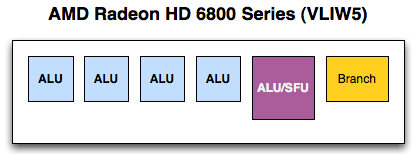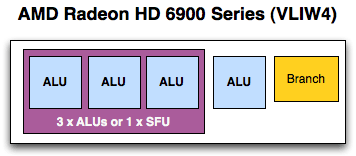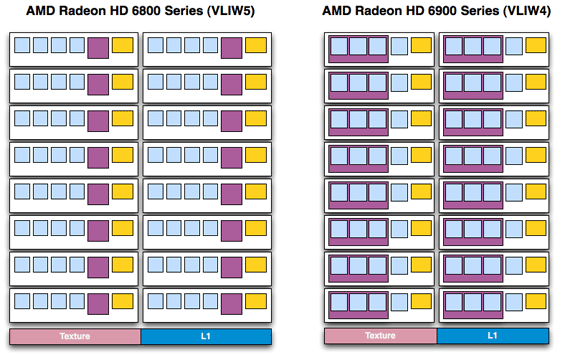AMD's Radeon HD 6970 & Radeon HD 6950: Paving The Future For AMD
by Ryan Smith on December 15, 2010 12:01 AM ESTVLIW4: Finding the Balance Between TLP, ILP, and Everything Else
To properly frame why AMD went with a VLIW4 design we’d have to first explain why AMD went with a VLIW5 design. And to do that we’d have to go back even further to the days of DirectX 9, and thus that is where we will start.
Back in the days of yore, when shading was new and pixel and vertex shaders were still separate entities, AMD (née ATI) settled on a VLIW5 design for their vertex shaders. Based on their data this was deemed the ideal configuration for a vertex shader block, as it allowed them to process a 4 component dot product (e.g. w, x, y, z) and a scalar component (e.g. lighting) at the same time.
Fast forward to 2007 and the introduction of AMD’s Radeon HD 2000 series (R600), where AMD introduced their first unified architecture for the PC. AMD went with a VLIW5 design once more, as even though the product was their first DX10 product it still made sense to build something that could optimally handle DX9 vertex shaders. This was also well before GPGPU had a significant impact on the market, as AMD had at best toyed around with the idea late in the X1K series’ lifetime (and well after R600 was started).

Now let us jump to 2008, when Cayman’s predecessors were being drawn up. GPGPU computing is still fairly new – NVIDIA is at the forefront of a market that only amounts to a few million dollars at best – and DX10 games are still relatively rare. With 2+ years to bring up a GPU, AMD has to be looking forward at where things will be in 2010. Their predictions are that GPGPU computing will finally become important, and that DX9 games will fade in importance to DX10/11 games. It’s time to reevaluate VLIW5.
This brings us to the present day and the launch of Cayman. GPGPU computing is taking off, and DX10 & DX11 alongside Windows 7 are gaining momentum while DX9 is well past its peak. AMD’s own internal database of games tells them an interesting story: the average slot utilization is 3.4 – on average a 5th streaming processor is going unused in games. VLIW5, which made so much sense for DX9 vertex shaders is now becoming too wide, while scalar and narrow workloads are increasing in number. The stage is set for a narrower Streaming Processor Unit; enter VLIW4.
As you may recall from a number of our discussions on AMD’s core architecture, AMD’s architecture is heavily invested in Instruction Level Parallelism, that is having instructions in a single thread that have no dependencies on each other that can be executed in parallel. With VLIW5 the best case scenario is that 5 instructions can be scheduled together on every SPU every clock, a scenario that rarely happens. We’ve already touched on how in games AMD is seeing an average of 3.4, which is actually pretty good but still is under 80% efficient. Ultimately extracting ILP from a workload is hard, leading to a wide delta between the best and worst case scenarios.

Meanwhile all of this is in stark contrast to Thread Level Parallelism (TLP), which looks for threads that can be run at the same time without having any interdependencies. This is where NVIDIA has focused their energies at the high-end, as GF100/GF100 are both scalar architectures that rely on TLP to achieve efficient operation.
Ultimately the realization is that AMD’s VLIW5 architecture is not the best architecture going forward. Up until now it has made sense at a high efficiency gaming-oriented design, and even today in a gaming part like the 6800 series it’s still a reasonable choice. But AMD needs a new architecture for the future, not only as something that’s going to better fit their 3.4 shader average, but something that is better designed for compute workloads. AMD’s choice is an overhauled version of their existing architecture. Overall it’s built on a solid foundation, but VLIW5 is too wide to meet their future goals.
The solution is to shrink their VLIW5 SPU to a VLIW4 SPU. Specifically, the solution is to remove the t-unit, the architecture’s 5th SP and largest SP that’s capable of both regular INT/FP operations as well as being responsible for transcendental operations. In the case of regular INT/FP operations this means an SPU is reduced from being able to process 5 operations at once to 4. While in the case of transcendentals an SPU now ties together 3 SPs to process 1 transcendental in the same period of time, representing a much more severe reduction in theoretical performance as an SPU can only process 1 transcendental + 1 INT/FP per clock as opposed to 1 transcendental + 4 INT/FP operations (or any variations).

There are a number of advantages to this change. As far as compute is concerned, the biggest advantage is that much of the space previously allocated to the t-unit can now be scrounged up to build more SIMDs. Cypress had 20 SIMDs while Cayman has 24; on average Cayman’s shader block is 10% more efficient per mm2 than Cypress’s , taking in to account the fact that Cayman’s SPs are a bit larger than Cypress’ to pick up the workload the t-unit would handle. The SIMDs are further tied to a number of attributes: the number of texture units, the number of threads that can be in flight at once, and the number of FP64 operations that can be completed per clock. The latter is particularly important for AMD’s compute efforts, as they can now retire FP64 FMA/MUL operations at 1/4th their FP32 rate, in the case of a full Cayman up to 384/clock. Technically speaking they’re no faster per SPU, but with this layout change they have more SPUs to work with, improving their performance.

Fewer SPs per SIMD = More Space For More SIMDs
There are even ancillary benefits within the individual SPUs. While the SP count changed the register file did not, leading to less pressure on each SPU’s registers as now only 4 SPs vie for register space. Even scheduling is easier as there are fewer SPs to schedule and the fact that they’re all alike means the scheduler no longer has to take into consideration the difference between the w/x/y/z units and the t-unit.
Meanwhile in terms of gaming the benefits are similar. Games that were already failing to fully utilize the VLIW5 design now have additional SIMDs to take advantage of, and as rendering is still an embarrassingly parallel operation as far as threading is concerned, it’s very easy to further divide the rendering workload in to more threads to take advantage of this change. The extra SIMDs mean that Cayman has additional texturing horsepower over Cypress, and the overall compute:texture ratio has been reduced, a beneficial situation for any games that are texture/filtering bound more than they’re compute bound.
Of course any architectural change involves tradeoffs, so it’s not a pure improvement. For gaming the tradeoff is that Cayman isn’t going to be well suited to VLIW5-style vertex shaders; generally speaking games using such shaders already run incredibly fast, but if they’re even GPU-bound in the first place they’re not going to gain much from Cayman. The other big tradeoff is when transcendental operations are paired with vector operations, as Cypress could handle both in one clock while Cayman will take two. It’s AMD’s belief that these operations are rare enough that the loss of performance in this one situation is worth it for the gain in performance everywhere else.
It’s worth noting that AMD still considers VLIW4 to be a risky/experimental design, or at least this is their rationale for going with it first on Cayman while sticking to VLIW5 elsewhere. At this point we’d imagine the real experiment to already be over, as AMD would already be well in the middle of designing Cayman’s 28nm successor, so they undoubtedly know if they’ll be using VLIW4 in the future.
Finally, the switch to a new VLIW architecture means the AMD driver team has to do some relearning. While VLIW4 is quite similar to VLIW5 it’s not by any means identical, which is both good and bad for performance purposes. The bad news is that it means many of AMD’s VLIW5-centric shader compiler tricks are no longer valid; at the start shader compiler performance is going to be worse while AMD learns how to better program a VLIW4 design. The good news is that in time they’re going to learn how to better program a VLIW4 design, meaning there’s the potential for sizable performance increases throughout the lifetime of the 6900 series. That doesn’t mean they’re guaranteed, but we certainly expect at least some improvement in shader performance as the months wear on.
On that note these VLIW changes do mean that some code is going to have to be rewritten to better deal with the reduction of VLIW width. AMD’s shader compiler goes through a number of steps to try to optimize code, but if kernels were written specifically to organize instructions to go through AMD’s shaders in a 5-wide fashion, then there’s only so much AMD’s compiler can do. Of course code doesn’t have to be written that way, but it is the best way to maximize ILP and hence shader performance.
VLIW5:
- 4 32-bit FP MAD
- Or 2 64-bit FP MUL or ADD
- Or 1 64-bit FP MAD
- Or 4 24-bit Int MUL or ADD
- Plus 1 transcendental or 1 32-bit FP MAD
VLIW4:
- 4 32-bit FP MAD/MUL/ADD
- Or 2 64-bit FP ADD
- Or 1 64-bit FP MAD/FMA/MUL
- Or 4 24-bit INT MAD/MUL/ADD
- Or 4 32-bit INT ADD/Bitwise
- Or 1 32-bit MAD/MUL
- Or 1 64-bit ADD
- Or 1 transcendental plus 1 32-bit FP MAD










168 Comments
View All Comments
mac2j - Wednesday, December 15, 2010 - link
Um - if you have the money for a 580 ... pick up another $80-100 and get 2 x 6950 - you'll get nearly the best possible performance on the market at a similar cost.Also I agree that Nvidia will push the 580 price down as much as possible... the problem is that if you believe all of the admittedly "unofficial" breakdowns ... it costs Nvidia 1.5-2x as much to make a 580 as it costs AMD to make a 6970.
So its hard to be sure how far Nvidia can push down the price on the 580 before it ceases to become profitable - my guess is they'll focus on making a 565 type card which has almost 570 performance but for a manufacturing cost closer to what a 460 runs them.
fausto412 - Wednesday, December 15, 2010 - link
yeah. AMD let us down on this here product. We see what gtx580 is and what 6970 is...i would say if you planning to spend 500...the gtx580 is worth it.truepurple - Wednesday, December 15, 2010 - link
"support for color correction in linear space"What does that mean?
Ryan Smith - Wednesday, December 15, 2010 - link
There are two common ways to represent color, linear and gamma.Linear: Used for rendering an image. More generally linear has a simple, fixed relationship between X and Y, such that if you drew the relationship it would be a straight line. A linear system is easy to work with because of the simple relationship.
Gamma: Used for final display purposes. It's a non-linear colorspace that was originally used because CRTs are inherently non-linear devices. If you drew out the relationship, it would be a curved line. The 5000 series is unable to apply color correction in linear space and has to apply it in gamma space, which for the purposes of color correction is not as accurate.
IceDread - Wednesday, December 15, 2010 - link
Yet again we do not get to see hd 5970 in crossfire despite it being a single card! Is this an nvidia site?Anyway, for those of you who do want to see those results, here is a link to a professional Swedish site!
http://www.sweclockers.com/recension/13175-amd-rad...
Maybe there is some google translation available or so if you want to understand more than the charts shows.
medi01 - Wednesday, December 15, 2010 - link
Wow, 5970 in crossfire consumes less than 580 in SLI.http://www.sweclockers.com/recension/13175-amd-rad...
ggathagan - Wednesday, December 15, 2010 - link
Absolutely!!!There's no way on God's green earth that Anandtech doesn't currently have a pair of 5970's on hand, so that MUST be the reason.
I'll go talk to Anand and Ryan right now!!!!
Oh, wait, they're on a conference call with Huang Jen-Hsun.....
I'd like to note that I do not believe Anadtech ever did a test of two 5970's, so it's somewhat difficult to supply non-existent into any review.
Ryan did a single card test in November 2009.That is the only review I've found of any 5970's on the site.
vectorm12 - Wednesday, December 15, 2010 - link
I was not aware of the fact that the 32nm process had been canned completely and was still expecting the 6970 to blow the 580 out of the water.Although we can't possibly know and are unlikely to ever find out what cayman at 32nm would have performed like I suspect AMD had to give up a good chunk of performance to fit it on the 389mm^2 40nm die.
This really makes my choice easy as I'll pickup another cheap 5870 and run my system in CF.
I think I'll be able to live with the performance until the refreshed cayman/next gen GPUs are ready for prime time.
Ryan: I'd really like to see what ighashgpu can do with the new 6970 cards though. Although you produce a few GPGPU charts I feel like none of them really represent the real "number-crunching" performance of the 6970/6950.
Ivan has already posted his analysis in his blog and it seems like the change from LWIV5 to LWIV4 made a negligible impact at the most. However I'd really love to see ighashgpu included in future GPU tests to test new GPUs and architectures.
Thanks for the site and keep up the work guys!
slagar - Wednesday, December 15, 2010 - link
Gaming seems to be in the process of bursting its own bubble. Graphics of games isn't keeping up with the hardware (unless you cound gaming on 6 monitors) because most developers are still targeting consoles with much older technology.Consoles won't upgrade for a few more years, and even then, I'm wondering how far we are from "the final console generation". Visual improvements in graphics are becoming quite incremental, so it's harder to "wow" consumers into buying your product, and the costs for developers is increasing, so it's becoming harder for developers to meet these standards. Tools will always improve and make things easier and more streamlined over time I suppose, but still... it's going to be an interesting decade ahead of us :)
darckhart - Wednesday, December 15, 2010 - link
that's not entirely true. the hardware now allows not only insanely high resolutions, but it also lets those of us with more stringent IQ requirements (large custom texture mods, SSAA modes, etc) to run at acceptable framerates at high res in intense action spots.